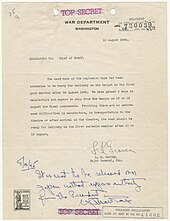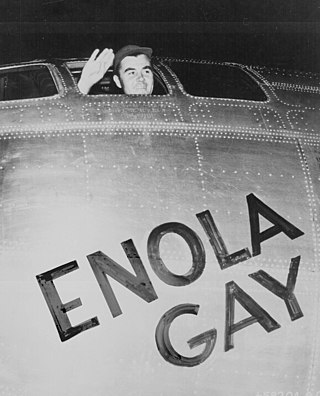
The Enola Gay is a Boeing B-29 Superfortress bomber, named after Enola Gay Tibbets, the mother of the pilot, Colonel Paul Tibbets. On 6 August 1945, during the final stages of World War II, it became the first aircraft to drop an atomic bomb in warfare. The bomb, code-named "Little Boy", was targeted at the city of Hiroshima, Japan, and caused the destruction of about three quarters of the city. Enola Gay participated in the second nuclear attack as the weather reconnaissance aircraft for the primary target of Kokura. Clouds and drifting smoke resulted in Nagasaki, a secondary target, being bombed instead.
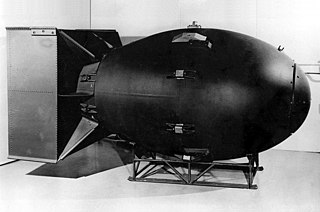
"Fat Man" was the codename for the type of nuclear weapon the United States detonated over the Japanese city of Nagasaki on 9 August 1945. It was the second of the only two nuclear weapons ever used in warfare, the first being Little Boy, and its detonation marked the third nuclear explosion in history. It was built by scientists and engineers at Los Alamos Laboratory using plutonium from the Hanford Site, and one was dropped from the Boeing B-29 Superfortress Bockscar piloted by Major Charles Sweeney.

Little Boy was the name of the type of atomic bomb used in the bombing of the Japanese city of Hiroshima on 6 August 1945 during World War II, making it the first nuclear weapon used in warfare. The bomb was dropped by the Boeing B-29 Superfortress Enola Gay piloted by Colonel Paul W. Tibbets Jr., commander of the 509th Composite Group, and Captain Robert A. Lewis. It exploded with an energy of approximately 15 kilotons of TNT (63 TJ) and had an explosion radius of approximately 1.3 kilometers which caused widespread death across the city. The Hiroshima bombing was the second nuclear explosion in history, after the Trinity nuclear test.

The Manhattan Project was a program of research and development undertaken during World War II to produce the first nuclear weapons. It was led by the United States in collaboration with the United Kingdom and Canada. From 1942 to 1946, the project was under the direction of Major General Leslie Groves of the U.S. Army Corps of Engineers. Nuclear physicist J. Robert Oppenheimer was the director of the Los Alamos Laboratory that designed the bombs. The Army program was designated the Manhattan District, as its first headquarters were in Manhattan; the name gradually superseded the official codename, Development of Substitute Materials, for the entire project. The project absorbed its earlier British counterpart, Tube Alloys. The Manhattan Project employed nearly 130,000 people at its peak and cost nearly US$2 billion, over 80 percent of which was for building and operating the plants that produced the fissile material. Research and production took place at more than 30 sites across the US, the UK, and Canada.

Trinity was the code name of the first detonation of a nuclear weapon, conducted by the United States Army at 5:29 a.m. MWT on July 16, 1945, as part of the Manhattan Project. The test was of an implosion-design plutonium bomb, nicknamed the "gadget", of the same design as the Fat Man bomb later detonated over Nagasaki, Japan, on August 9, 1945. Concerns about whether the complex Fat Man design would work led to a decision to conduct the first nuclear test. The code name "Trinity" was assigned by J. Robert Oppenheimer, the director of the Los Alamos Laboratory, inspired by the poetry of John Donne.

Louis Alexander Slotin was a Canadian physicist and chemist who took part in the Manhattan Project. Born and raised in the North End of Winnipeg, Manitoba, Slotin earned both his Bachelor of Science and Master of Science degrees from the University of Manitoba, before obtaining his doctorate in physical chemistry at King's College London in 1936. Afterwards, he joined the University of Chicago as a research associate to help design a cyclotron.
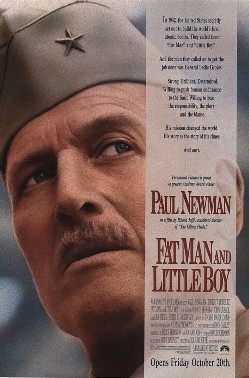
Fat Man and Little Boy is a 1989 American epic historical war drama film directed by Roland Joffé, who co-wrote the script with Bruce Robinson. The story follows the Manhattan Project, the secret Allied endeavor to develop the first nuclear weapons during World War II. The film is named after "Little Boy" and "Fat Man", the two bombs dropped on the Japanese cities of Hiroshima and Nagasaki, respectively.

Haroutune Krikor Daghlian Jr. was an American physicist with the Manhattan Project, which designed and produced the atomic bombs that were used in World War II. He accidentally irradiated himself on August 21, 1945, during a critical mass experiment at the remote Omega Site of the Los Alamos Laboratory in New Mexico and died 25 days later from the resultant radiation poisoning.

Seth Henry Neddermeyer was an American physicist who co-discovered the muon, and later championed the implosion-type nuclear weapon while working on the Manhattan Project at the Los Alamos Laboratory during World War II.
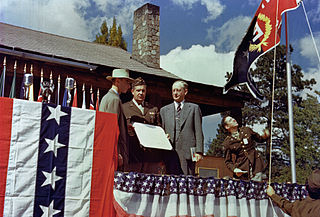
The Manhattan Project was a research and development project that produced the first atomic bombs during World War II. It was led by the United States with the support of the United Kingdom and Canada. From 1942 to 1946, the project was under the direction of Major General Leslie Groves of the US Army Corps of Engineers. The Army component of the project was designated the Manhattan District; "Manhattan" gradually became the codename for the entire project. Along the way, the project absorbed its earlier British counterpart, Tube Alloys. The Manhattan Project began modestly in 1939, but grew to employ more than 130,000 people and cost nearly US$2 billion. Over 90% of the cost was for building factories and producing the fissionable materials, with less than 10% for development and production of the weapons.

Project Alberta, also known as Project A, was a section of the Manhattan Project which assisted in delivering the first nuclear weapons in the atomic bombing of Hiroshima and Nagasaki during World War II.

Hiroshima is a 1995 Japanese-Canadian war drama film directed by Koreyoshi Kurahara and Roger Spottiswoode about the decision-making processes that led to the dropping of the atomic bombs by the United States on the Japanese cities of Hiroshima and Nagasaki toward the end of World War II. The three-hour film was made for television and had no theatrical release.
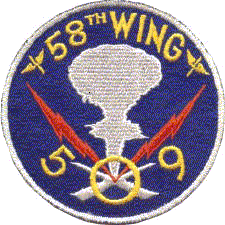
The 509th Composite Group was a unit of the United States Army Air Forces created during World War II and tasked with the operational deployment of nuclear weapons. It conducted the atomic bombings of Hiroshima and Nagasaki, Japan, in August 1945.

"Thin Man" was the code name for a proposed plutonium-fueled gun-type nuclear bomb that the United States was developing during the Manhattan Project. Its development was abandoned in 1944 after it was discovered that the spontaneous fission rate of nuclear reactor-bred plutonium was too high for use in a gun-type design due to the high concentration of the isotope plutonium-240.
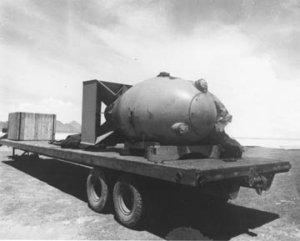
Pumpkin bombs were conventional aerial bombs developed by the Manhattan Project and used by the United States Army Air Forces against Japan during World War II. It was a close replication of the Fat Man plutonium bomb with the same ballistic and handling characteristics, but it used non-nuclear conventional high explosives. It was mainly used for testing and training purposes, which included combat missions flown with pumpkin bombs by the 509th Composite Group. The name "pumpkin bomb" was the term used in official documents from the large, fat ellipsoidal shape of the munition casing instead of the more usual cylindrical shape of other bombs, intended to enclose the Fat Man's spherical "physics package".

On 6 and 9 August 1945, the United States detonated two atomic bombs over the Japanese cities of Hiroshima and Nagasaki. The bombings killed between 129,000 and 226,000 people, most of whom were civilians, and remain the only use of nuclear weapons in an armed conflict. Japan surrendered to the Allies on 15 August, six days after the bombing of Nagasaki and the Soviet Union's declaration of war against Japan and invasion of Japanese-occupied Manchuria. The Japanese government signed the instrument of surrender on 2 September, effectively ending the war.
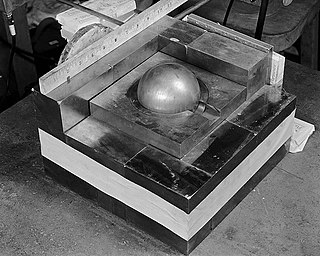
The demon core was a sphere of plutonium that was involved in two fatal radiation accidents when scientists tested it as a fissile core of an early atomic bomb. It was manufactured by the Manhattan Project, the U.S. nuclear weapon development effort during World War II. It was a subcritical mass that weighed 6.2 kilograms (14 lb) and was 8.9 centimeters (3.5 in) in diameter.

Raemer Edgar Schreiber was an American physicist from McMinnville, Oregon who served Los Alamos National Laboratory during World War II, participating in the development of the atomic bomb. He saw the first one detonated in the Trinity nuclear test in July 1945, and prepared the Fat Man bomb that was used in the bombing of Nagasaki. After the war, he served at Los Alamos as a group leader, and was involved in the design of the hydrogen bomb. In 1955, he became the head of its Nuclear Rocket Propulsion (N) Division, which developed the first nuclear-powered rockets. He served as deputy director of the laboratory from 1972 until his retirement in 1974.

Marshall Glecker Holloway was an American physicist who worked at the Los Alamos Laboratory during and after World War II. He was its representative, and the deputy scientific director, at the Operation Crossroads nuclear tests at Bikini Atoll in the Pacific in July 1946. Holloway became the head of the Laboratory's W Division, responsible for new weapons development. In September 1952 he was charged with designing, building and testing a thermonuclear weapon, popularly known as a hydrogen bomb. This culminated in the Ivy Mike test in November of that year.

The Los Alamos Laboratory, also known as Project Y, was a secret laboratory established by the Manhattan Project and operated by the University of California during World War II. Its mission was to design and build the first atomic bombs. Robert Oppenheimer was its first director, serving from 1943 to December 1945, when he was succeeded by Norris Bradbury. In order to enable scientists to freely discuss their work while preserving security, the laboratory was located on the isolated Pajarito Plateau in Northern New Mexico. The wartime laboratory occupied buildings that had once been part of the Los Alamos Ranch School.

